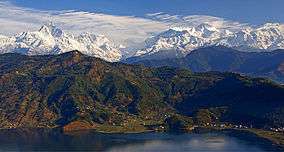Annapurna Conservation Area
| Annapurna Conservation Area | |
|---|---|
|
IUCN category VI (protected area with sustainable use of natural resources) | |
|
Annapurna range as seen from Pokhara | |
 | |
| Location | Nepal |
| Coordinates | 28°47′N 83°58′E / 28.78°N 83.97°ECoordinates: 28°47′N 83°58′E / 28.78°N 83.97°E |
| Area | 7,629 km2 (2,946 sq mi) |
| Established | 1992 |
| Governing body | Department of National Parks and Wildlife Conservation, Ministry of Forests |
The Annapurna Conservation Area is Nepal's largest protected area covering 7,629 km2 (2,946 sq mi) in the Annapurna range of the Himalayas across the Manang, Mustang, Kaski, Myagdi, and Lamjung districts. The area ranges in altitude from 790 m (2,590 ft) to the peak of Annapurna I at 8,091 m (26,545 ft).[1]
History
The Annapurna Conservation Area was established in 1985 and gazetted in 1992. It is managed by the National Trust for Nature Conservation.[1]
Climate
There are two distinct climatic regions within a span of 120 km (75 mi) and an altitude of 1,000 to 8,000 m (3,300 to 26,200 ft). Annual rainfall averages 3,000 mm (120 in) in the south, and less than 500 mm (20 in) in the north.[1]
References
- 1 2 3 Bhuju, U.R., Shakya, P.R., Basnet, T.B., Shrestha, S. (2007). Nepal Biodiversity Resource Book. Protected Areas, Ramsar Sites, and World Heritage Sites. International Centre for Integrated Mountain Development, Ministry of Environment, Science and Technology, in cooperation with United Nations Environment Programme, Regional Office for Asia and the Pacific. Kathmandu, Nepal. ISBN 978-92-9115-033-5
External links
| ||||||||||||||||||||||
This article is issued from Wikipedia - version of the Friday, July 17, 2015. The text is available under the Creative Commons Attribution/Share Alike but additional terms may apply for the media files.
